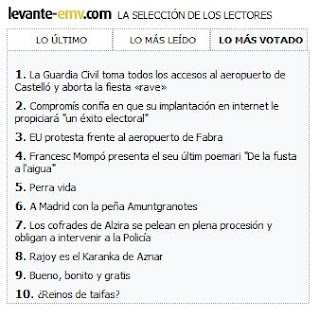 |
| Wave Traces Islamic |
Josep Vicent
Ricardo González Lerma Villaescusa
Levante-EMV, Sunday April 24, 2011
After some years restraining congressional dynamics to use, as the Andalusian Archaeological Science, subjected to sleep of the righteous among us, the symposium "The palaces as an expression of power: the Andalusian and survival models" in Onda (Castellón), 29 April to May 1, leads almost inevitably to paraphrase is the work of Juan Goytisolo, 1986.
The conference organized by the Laboratory for Archaeology and Architecture of the City (LAAC) to Granada (CSIC) and the town of Onda, speaks of a thriving array of researchers and has a large cut of guests, many of them linked for decades to land Sharq al-Andalus from the old Valencia, among which we have been providing chair in the stalls. Even begins to miss the wise regarding our past Arab Pierre Guichard.
Take, therefore, rest in the position of an item of 'fashion' as is' Taifa Palace of the Alcazaba Wave "(sic). Although we know that the words and semantics are loaded by the devil, no shadow of doubt can be entertained for an historic hisn Wave in the centuries of al-Andalus, as already quoted in the itineraries of al-Udri (1003-1085). This rural site would only have a moment of expansion almost bordering on the urban, during the last century before the conquest by Jaume I of Aragon. Such a scenario is demonstrated in the work of the eighties of last century archaeologists Bazzana André, whose encyclopedic Maisons d'Al-Andalus: habitat médiévale et Structures du peuplement dans l'Espagne orientale (1992), but attributed consideration of small regional center, all under the tutelage of the only authentic urban madina de la Plana, Borriana. It is also significant in its default state of the "Ten Years of Medieval Archaeology Valencia", which the illustrious Rafael Azuar presented in Jornades Valenciana d'Arqueologia L'Alfas del Pi, 1994.
 |
| rainwater reservoir Pool Wave |
In what some see as unprecedented residential courtly Taifa, the Islamic Unda, we actually seem to recognize a group of fortifications in no case would place their morphology prior to the last throes of the eleventh century. In the stimulant plant enclosure fortress previous models should not be sought inspiration in remote deserts or in distant lands, which rose as the Umayyad palaces Mshatta (Jordan), even should outweigh the fact reliable country construction materials, textures and rigging of a typical rectangular room changing, with paintings and round towers that reinforce the corners and line the curtains with the rhythm Murari occurs in many other strengths Andalus.
A clever plot, a factories and textures that appear to be so far from the Aljafería Zaragoza palace complex and place great power of the dynasty of the Hudi, like so near the site of Almiserat (Vall de Gallinera, Pego), with impressions of possible origin Caliphate . The relative antiquity of the trace of some of the walls seems attested by the remains unearthed during archaeological painstaking process. In contrast, the formulation of the enclosure wall of the citadel, stuffed full of turrets, an argument should not become unavoidable in order to draw parallels with reputable fencing palate.
Inside the Wave qasba, the manor belonged dominant to a period in our position and accidental visitor on the basis of our own knowledge of Islamic houses of this time in the cities of Denia, Alzira and Valencia, as the noble de l'Almoina or Busianos Marquis Square , somewhere between the last third of the twelfth century and the first XIII. Onda was made clear in the remains of something that would define as a mansion of arcaded courtyard with perimeter dock, cruise and pool in one of its sides, which uses all available space in the upper enclosure. A house, a big house indeed, with solutions similar to those found in some enclaves of the "madina Balansiya" as above, o en la terraza superior de la medina de Xàtiva, en el Bellveret.
Por consiguiente, en tanto la deseable publicación científica no disipe toda duda con argumentos de mayor enjundia que los genéricos del estilo de lo «más antiguo» y/o «más grande», nuestra visura sobre Unda es la de un pródigo hisn, con un proceso de fortificación en unas fechas ajenas al fulgor de las primeras taifas (circa 1.100 A.D.). Un siglo más tarde, el espacio de la acrópolis sería ocupado por una emblemática edificación, sin duda vinculada a un destacado gobernante como, por qué no, el propio Zayyan ibn Mardanish , señor This castle. A relict area, topographically excellent, within which built a transparent noble house. With ornate bedrooms and apartments, though lacking any ornament of witness sunset, beyond the ocher stucco and wide porches and where the subsequent abandonment contexts, suggest no major proposals for reconstruction before the Conquest feudal, and in our opinion even palatal necessarily authorize dilapidated dreams.
article among the 10 most voted by readers of Levante-EMV









